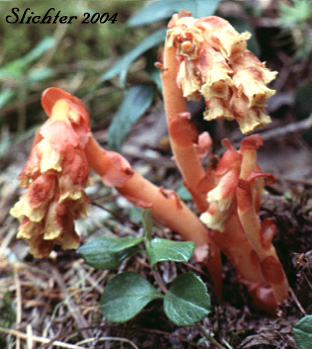 The
photo at right shows pinesap as seen near Cooper Lake, Wenatchee NF.......July
15, 1978. The leaves of twin flower, Linnaea borealis
are found at its base.
The
photo at right shows pinesap as seen near Cooper Lake, Wenatchee NF.......July
15, 1978. The leaves of twin flower, Linnaea borealis
are found at its base.
Lacking chlorophyll as it is a saprophyte, pinesap is an interesting wildflower, especially due to its coloration and nodding flower heads. It is also of interest as it often appears in the bare humus soils in fairly deep shade. Plants have one to several erect and unbranched stems arising from 5-25 cm high. The stems and flowers are yellowish to pink or straw-colored, drying to black after flowering. The leaves are ovate with entire to fringed margins.
The inflorescence is a recurved raceme which becomes erect after bloom. The pedicels are 3-6 mm long while the 2-5 sepals are 5-9 mm long. The 3-5 petals are up to 18 mm long and strongly overlap one another. The individual petals have a small pouch near the inner base and range from glabrous to hairy on one or both surfaces. The 6-10 stamens are shorter than the corolla. The style is hairy while the stigma is slightly lobed an about at the same level as the mouth of the corolla.
Pinesap is found in thick, humus soils of coniferous forests.
Pinesap may be found from British Columbia south to Mendocino County, California and east to the Atlantic Coast. It is also found in Europe.
In the Columbia River Gorge, it may be found between the elevations of 2000'-4300' from Silver Star Mt. and Larch Mt. in the west to the peaks to the west of the Little White Salmon River in Washington and Mt. Defiance in Oregon.